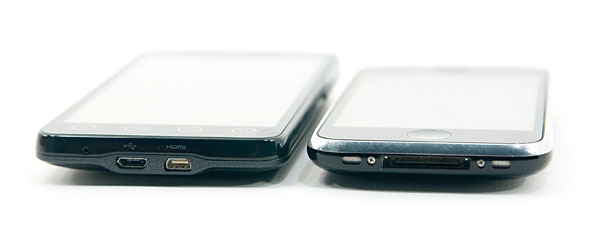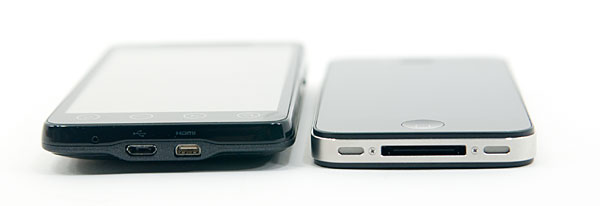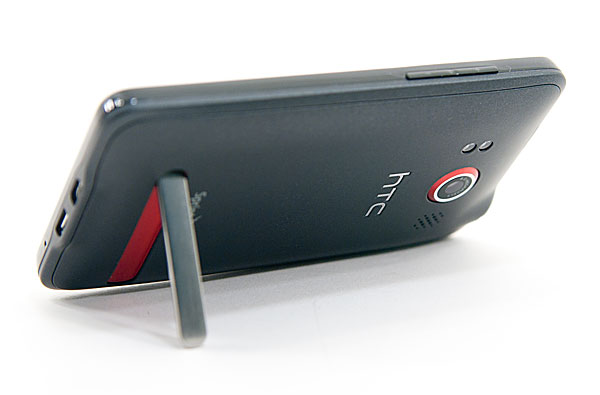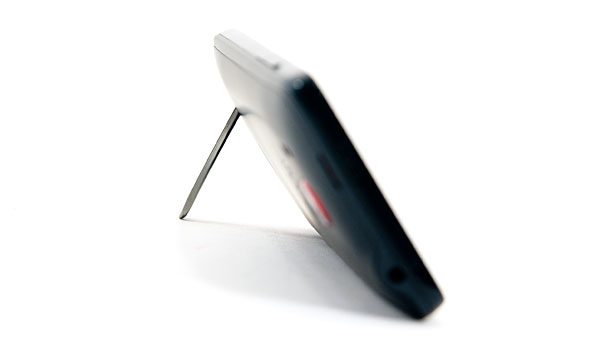The Sprint HTC EVO 4G Review
by Anand Lal Shimpi on June 28, 2010 6:04 PM ESTIt’s really not that big. It seems like it would be based on the specs and photos, but in reality the Sprint EVO 4G by HTC just isn’t that big. And it’s not levied as an insult, I just mean to say that the EVO is manageable in size.
The screen has the same 800 x 480 resolution of the Nexus One and HTC Incredible, but the pixels are spread out over a much larger 4.3” screen. The display setup to be overly red just like the other Android screens we've seen thus far, but it looks great.

The size of the screen is really what sets the EVO 4G apart from the competition, and honestly I couldn’t think of a better phone for browsing the web. Loading full websites is a pleasure and the screen is large enough where you can actually read a lot of content. It's not a tablet replacement, but it is easier to work with than a 3.5 - 3.7" screen.

From left to right: HTC EVO 4G, iPhone 3GS, Nexus One, iPhone 4
I’ve heard it referred to as a mini tablet and honestly I don’t believe that’s the case. The 4.3” screen is big but I’m telling you, it’s not that big in practice. It just ends up feeling like a phone with a good sized screen. Move into the 5” and beyond territory and then you start triggering me calling things tablets.

HTC EVO 4G (left) vs. iPhone 3GS (right)

HTC EVO 4G (left) vs. iPhone 4 (right)
The phone measures 4.8” x 2.6” x 0.5” and it’s the largest smartphone I’ve ever held. That being said, it is absolutely pocketable as long as you’re not wearing skinny jeans. Even then it is thin enough that you could slip it into your back pocket.
| Physical Comparison | |||||||
| HTC EVO 4G (Qualcomm Snapdragon QSD8650) | HTC Droid Incredible (Qualcomm Snapdragon QSD8650) | Apple iPhone 4 | Google Nexus One (Qualcomm Snapdragon QSD8250) | ||||
| Height | 121.9 mm (4.8") | 117.5 mm (4.63") | 115.2 mm (4.5") | 119 mm (4.7") | |||
| Width | 66.0 mm (2.6") | 58.5 mm (2.30") | 58.6 mm (2.31") | 59.8 mm (2.35") | |||
| Depth | 12.7 mm (0.5") | 11.9 mm (0.47") | 9.3 mm ( 0.37") | 11.5 mm (0.45") | |||
| Weight | 170 g (6.0 oz) | 130 g (4.6 oz) | 137 g (4.8 oz) | 130 g (4.6 oz) | |||
| CPU | Qualcomm Scorpion @ 1GHz | Qualcomm Scorpion @ 1GHz | Apple A4 @ ~800MHz | Qualcomm Scorpion @ 1GHz | |||
| GPU | Adreno 200 | Adreno 200 | PowerVR SGX 535 | Adreno 200 | |||
| RAM | 512MB LPDDR1 | 512MB LPDDR1 | 512MB LPDDR1 (?) | 512MB LPDDR1 | |||
| NAND | 8GB micro SD | 8GB micro SD | 16GB or 32GB integrated | micro SD | |||
| Camera | 8MP with dual LED Flash + Front Facing Camera | 8MP with LED Flash | 5MP with LED Flash + Front Facing Camera | 5MP with LED Flash | |||
| Screen | 4.3" 480 x 800 | 3.7" 480 x 800 AMOLED | 3.5" 640 x 960 LED backlit LCD | 3.7" 480 x 800 AMOLED | |||
| Battery | Removable 5.5Whr | Removable 4.81 Whr | Integrated 5.254 Whr | Removable 5.18 Whr | |||
HTC ditched the silly scroll ball of the Nexus One and the optical sensor of the Incredible and just left the EVO 4G with a row of touch sensitive buttons along the base of the screen. Home, Menu, Back and Search are all you get.
If you need a navigational aid the screen is big enough where HTC was able to include directional arrows on the on-screen keyboard. They are awkward to use at first because you’re not used to them, but afterwards they just make sense. I hardly used the scroll ball/optical trackball of the other Android phones so HTC’s decision to reclaim that real estate makes total sense to me. The screen is used for scrolling, if you need fine tuned movement just rely on the virtual arrow keys. Fine by me.
The touch screen supports haptics, which can be fully disabled. When enabled certain button presses will cause the EVO’s motor to vibrate a bit to confirm the touch. It’s a concession for those who still want some tactile feedback.

The EVO 4G is the first Android phone I’ve used with something interesting on its back: a kickstand. The metal stand lets you prop a horizontally oriented EVO on your desk at around a 45 degree angle. It’s great for watching videos, using as a clock or an alternative to a costly dock.

The stand is actually a nice touch, unfortunately the Android UI doesn’t rotate to landscape mode so it’s only useful within apps that support rotation.
Also on the back is the 8MP camera lens (there’s a 1.3MP camera on the front), two LED lights used as a flash and a speaker for the speakerphone. Along the bottom is a standard USB micro B connector and a micro HDMI (D-connector) video out. The HDMI out can only be used to output movies, it won’t mirror your display.

As its name bluntly states, the EVO 4G works on Sprint’s 4G WiMAX network. Sprint’s 4G service is currently only available in 43 cities spread over 15 states, if you find yourself in one of those states then the EVO has more than its large screen to tempt you.
The phone currently sells subsidized for $199 from Sprint after a $100 mail in rebate. Service starts at $69.99 for 450 minutes and unlimited messaging/data and goes all the way up to $134.99 per month including tethering.
| Cost of Ownership Comparison | |||||
| AT&T iPhone 4 | Sprint EVO 4G | Verizon HTC Droid Incredible | |||
| Cost of Device | $199 w/ 2 year contract | $199 w/ 2 year contract after $100 MIR | $199 w/ 2 year contract | ||
| Plan with 900 Minutes, Unlimited SMS/Data | $104.99/mo, unlimited SMS, 2GB data | $99.99/mo, unlimited SMS, unlimited data, 4G | $109.98/mo, unlimited SMS, unlimited data | ||
| Tethering | + $20/mo | + $29.99/mo | + $25/mo* | ||
| Total Monthly + Tethering | $124.99/mo | $129.98/mo | $134.98/mo | ||
| Total Cost of Ownership over 2 Years | $2718.76 | $2598.76 after $100 MIR | $2838.52 | ||
| Total Cost of Ownership over 2 Years w/ Tethering | $3198.76 | $3318.52 after $100 MIR | $3438.52 | ||
Without the mobile hotspot service, the EVO 4G is the most affordable smartphone out of the three majors over the course of two years. AT&T actually offers a better deal with tethering but you need to keep an eye on your usage; go over 2GB per month and you'll incur additional charges, which isn't tough to do if you tether a lot.










97 Comments
View All Comments
tommo123 - Tuesday, June 29, 2010 - link
any chance of revies of some apps?i.e for android keyboards, swype is awesome - best keyboard i've used
stryder76 - Tuesday, June 29, 2010 - link
Sprint/HTC has released an OTA update yesterday. Supposedly, the EVO is now faster or at least feels snappier.Will you redo the benchmark tests?
cknobman - Tuesday, June 29, 2010 - link
LOL only thing the OTA update yesterday did was brick alot of phones (including mine)!!!!!What kind of idiotic developer dosnt do a software check before installing new software? And what half assed QA team dosnt check for that scenario and lets the crap code roll out to production?
For those that arent aware the problem was the OTA update installs fine the first time then shortly later the user is notified a upgrade is available (apparently same one you just applied) and when the user tries to apply update instant bricked phone!!!!!!!
Its kind of my fault but after installing the first time I went home and was playing with my kids and surfing the web when my phone poped up the upgrade available again. I was busy and just hit ok thinking it was another upgrade in a series of progressive ones. Boy was I wrong. As a applications developer myself Im dumbfounded how some sh!tty code like this could roll out which is now going to cost sprint quite a bit of money.
Sprint has officially pulled the upgrade until they can fix this issue.
stryder76 - Tuesday, June 29, 2010 - link
You mentioned that there is a website that lists the virtual keyboards but all it states is "at .com". What website were you going to link to?BlueAqua - Tuesday, June 29, 2010 - link
Nice review Anand. Don't forget that Sprint makes you pay and extra $10 a month just to have an EVO. Undscountable too. Their new plans and this fee would have cost me over $2000 over my current similar plan for 2 phones, which really isn't worth it at all.rothnic - Tuesday, June 29, 2010 - link
Have you been trying to get your hands on a Droid X at all? I have really been hoping it would address most of the issues that the Evo has, while having the 4.3" screen. I have been comparing T-Mobile vs. Sprint vs. ATT vs. Verizon and think the Droid X might be the winner.Some reviews of the Droid X point to slightly better video and picture quality. (not as good as some iphone 4 samples I have seen, but a compromise)
No $10 charge for 4g that isn't even in my area.
No capped internet, which has turned me away from upgrading my 3 year old iPhone for the iPhone 4.
Better processor, so hopefully smoother experience(especially after 2.2).
Would like to see your review of it.
bigdeal101 - Tuesday, June 29, 2010 - link
Annand,Is it possible to do a Clear 4G review or Sprint non phone review. I have been considering getting 4G but for Broadband only. I would be especially interested in home vs. mobile option with respect to signal strength and usability. Also, if there are any antennas out there for 4G do they help much. Not everone is an internet phone warrior but they do use the internet with laptops in mobile situations.
Thanks from a 13 year fan. (I read your site when you were in High School as well as Sharky and the original Toms Hardware. Still also visit Kyle's Hard OCP. )
ergo98 - Tuesday, June 29, 2010 - link
"Unfortunately there’s no way to close an app from the task switcher although there are many options in the Android market if you want something a bit more robust."This isn't some grievous oversight. Most task killers do far more harm than good.
Apps in the background seldom consume anything more than RAM. The RAM they do consume is automatically freed the moment any other application requires it. The app is essentially "freeze-dried" to a minimalist bag of state, restored when you go back to it.
I am a little disappointed seeing this continued ignorance about Android, most especially on AnandTech. Sure there are people who'll tell you how great life is with a task killer, just as there are also people who will swear by their Q-Bracelet's magical curative powers. Eschew task killers and embrace the platform as it was actually intended -- it isn't Windows.
The only real caveat to this is services -- services do consume resources in the background, however by and large the only services in Android apps are actually critically necessary, such as background music playing or downloading. Services very seldom need to be managed in any form beyond the app GUI.
strikeback03 - Tuesday, June 29, 2010 - link
And there are plenty of users who believe the default settings allow suspended programs to hang around for too long, esp. on Sense devices.http://www.androidcentral.com/fine-tuning-minfree-...
Impulses - Tuesday, June 29, 2010 - link
Meh, you'll find a never-ending discussion on the subject if you look around... But there's also plenty of OTHER things you can do to conserve battery life. The stock sync settings for FB/News/whatever accounts are a little too aggressive if you ask me, that's the obvious place to start. Alternate launchers are said to help as well, I haven't really compared battery life w/ADW vs Sense...Personally Sense's launcher's UI seems silly to me, why do I need a permanent button on my home screen to just add more app shortcuts and widgets? And why is the phone button so large? Wasted space... That being said, a lot of the other Sense add-ons are very welcome (like the contact linking across accounts, which can be done manually, thankfully). Luckily you can dump the launcher and keep the rest.
Aaand that's pretty much what Android's all about, choice. Some of the custom ROMs out there do wonders for battery life as well, alto that goes well beyond the scope of a product review (as anything that requires rooting/jailbreaking does). But switching launchers or simply tweaking stock settings should be in the discussion at some point imo. It's a degree of customization that you don't (easily) get w/other phones/OS.